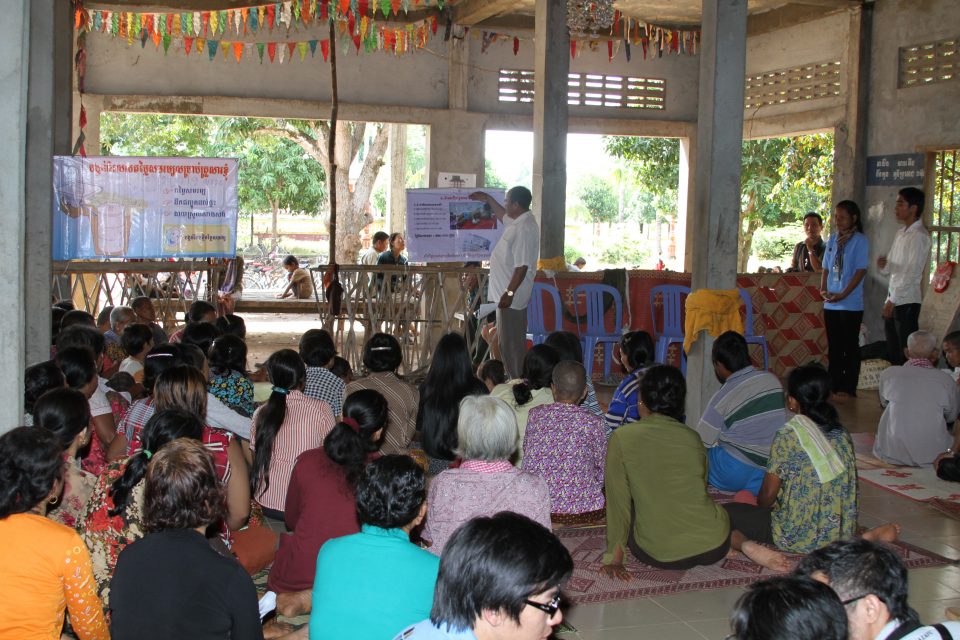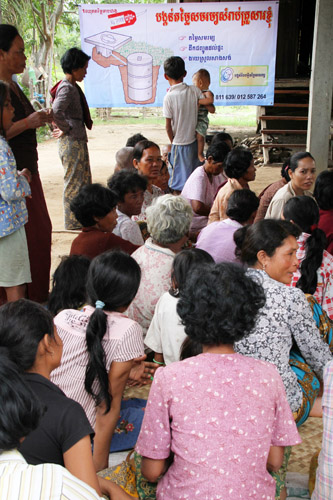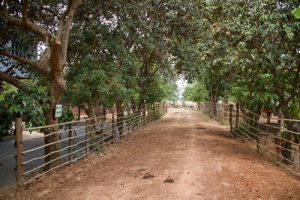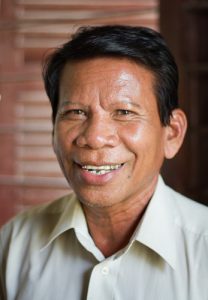Hands-Off Marketing: Helping to fill the sanitation gap
In Cambodia, a country where 75 percent of rural villagers do not have toilets, Skuh Commune in Kampong Speu Province is proving that achieving Open Defecation Free status is not just development talk, but a real target that is being met. With several of the Commune’s villages already at 100% sanitation access, understanding the history of their sanitation pitfalls and inspirational success could help unlock a formula to speed up sanitation coverage throughout Cambodia.
WaterSHED’s Hands-Off approach to sanitation marketing, in collaboration with the Kampong Speu Provincial Department of Rural Development (PDRD), is demonstrating that with supply chain facilitation, dramatic sanitation coverage can be achieved in a relatively short period of time. Building on a history of Community-led Total Sanitation (CLTS) in Skuh Commune, WaterSHED’s innovative sanitation marketing approach is filling important gaps in the sanitation supply chain to provide low-cost options for aspirational pour-flush latrines, previously out of reach for most villagers.
In 2009 CLTS triggered the first large-scale wave of dry pit latrines in Skuh Commune. Initiated by the PDRD, CLTS established lasting sanitation links between the provincial government, local officials and villagers. CLTS cultivated an essential base of sanitation education, infrastructure and village-level sanitation teams – small groups of village volunteers that initiated door-to-door sanitation campaigns to promote household installation of basic dry pit latrines. In Commune villages such as Prey Pongro the initial CLTS success was striking. “Soon after CLTS, dry pit latrines were installed at most households in the village and everyone in the village had access to a latrine – a few households shared latrines, but everyone at least had access”, said Village Chief Hang Sopheng.
Despite early success in containing open defecation, dry pits were never embraced as a long-term solution for the villages in Skuh Commune. According to Commune Chief Nheb Bunneang, CLTS was responsible for a successful surge of sanitation coverage, but the dry pit latrines that CLTS promoted were soon reduced to an undesirable, temporary solution. Villagers faced problems such as rapid decay of pit walls and wood materials, which led to pit collapse. Confounding the initial inspiration of CLTS, wet season flooding caused previously damaged and vulnerable dry pits to overflow, recycling the health problems associated with open defecation.
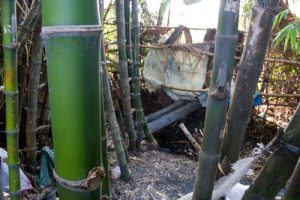
Despite early success in containing open defecation, dry pits were never embraced as a long-term solution for the villages in Skuh Commune. Villagers faced problems such as rapid decay of pit walls and wood materials, which led to pit collapse. Wet season flooding caused previously damaged and vulnerable dry pits to overflow, recycling the health problems associated with open defecation.
Expensive pour-flush toilets were available in 2009, and the few villagers who could afford them skipped dry pits altogether, but high cost and the difficulty of piecing together a reliable kit of pour-flush materials remained blocks to village-wide purchases. With a foundation of CLTS training, government support and dedicated village leaders, the Commune was perfectly primed for a large-scale transition to pour-flush latrines.
In 2009 the PDRD initiated promotion of pour-flush latrines in Skuh Commune, but the gap between toilet suppliers and villagers remained unfilled and the cost of the toilets, at hundreds of dollars, was still much too high. The momentum for change came in 2010 when a new collaboration between the government, WaterSHED and partner Lien Aid, facilitated the necessary linkages between the supply chain and consumers. The core of the new program was a low-cost latrine kit that could be purchased and delivered on the same day.
Villagers no longer had to navigate a disconnected supply chain to find toilet components. Suppliers came to them, price points were fixed and delivery was included. Easy.
Building from the sanitation groundwork laid by CLTS, village leaders were able to quickly mobilize a new drive for pour-flush adoption. The village of Prey Rongeang is a shining example of this transition.
Walking down Prey Rongeang’s tidy, bamboo-fence-lined streets there is an immediate impression that something is different here. A sign in front of the Village Chief’s house reads “Clean village, good health, good prosperity”, and this message is palpable; there isn’t rubbish strewn about, house-fronts are well kept and there is a calm confidence behind the bright smiles that greet visitors. “We welcome visitors to Prey Rongeang”, says villager Chhun Lum. “We are proud that our village has latrines. Before latrines, the rice paddies were our toilets and the fields smelled very bad. Not any more.” When asked why she chose to finally purchase a pour-flush latrine, some of the answers are common ones – safe, clean and convenient for her family. But the main reason? “The cost was low and the process was easy”.
Sanitation sales events are the key that makes the process so easy. Village leaders, in collaboration with program-supported sales agents and suppliers, convene community sales events where villagers have the opportunity to see and purchase latrine kits directly from the suppliers. The kits can be purchased for about 35 U.S. Dollars, a fraction of the cost of previous pour-flush latrines, and they are delivered the same day, usually within hours. And how do the sanitation enterprises feel about the program? According to supplier Chea Bunly “At every sales event, I sell all the toilet kits that I bring!”
Prey Rongeang Village Chief Sok Chhoeun has been the driving force behind his village’s nearly 100% sanitation coverage (all households have purchased pour-flush latrines, but 6 are still awaiting installation). He has been the main proponent of the village’s latrines beginning with CLTS and he has played many roles from sales agent to sanitation workshop trainer. He agrees that sanitation marketing is the reason why coverage has jumped so high in such a short time. “Sales and delivery are the best part. Just purchase and wait at home.” He also emphasizes that villagers now feel more trust in their purchase because the sales events have advocates in provincial and local government.
This government support is echoed by Commune Chief Bunneang, who also believes that latrine sales are high because of the lower cost and ease of purchase. He sees sanitation marketing as a prominent link in the program chain that begins with a PDRD plan for ODF status, and training of local authorities to promote latrine uptake. But government can’t do it alone and Commune Chief Bunneang is quick to emphasize that the three-party collaboration between PDRD, local authorities and WaterSHED is the pivotal force behind achieving the Commune’s sanitation goals. “With this program, all of the villages in Skuh Commune will achieve ODF status by 2015.”

